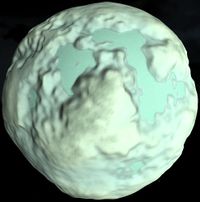Difference between revisions of "Tutorial:How to get to Minmus"
Andersenman (talk | contribs) m (→Introduction: fixed typo) |
Andersenman (talk | contribs) m (→Advanced method: fixed typo) |
||
| Line 53: | Line 53: | ||
* Burn to raise the apoapsis to around 10,000m. | * Burn to raise the apoapsis to around 10,000m. | ||
* Burn Easterly to achieve a low equatorial orbit. | * Burn Easterly to achieve a low equatorial orbit. | ||
| − | * When the craft is ahead of the moon in | + | * When the craft is ahead of the moon in its orbit, burn again to escape velocity, ensuring to stop the burn early. |
* You will now be on a [[Tutorial:Free Return Trajectory|"free return"]] type of trajectory to Kerbin. You will not need to burn again to re-enter the planet's atmosphere. | * You will now be on a [[Tutorial:Free Return Trajectory|"free return"]] type of trajectory to Kerbin. You will not need to burn again to re-enter the planet's atmosphere. | ||
Revision as of 21:11, 15 December 2012
This tutorial will attempt to teach you how to get to Minmus. It assumes that you have successfully completed a trip to The Mun, if you haven't I suggest you check out the tutorial.
Contents
Introduction
Landing on Minmus is almost identical to landing on the Mun, with a few minor exceptions:
- Minmus is further from Kerbin than the Mun, which means:
- More fuel is required from the trip between Kerbin's orbit and Minmus.
- It has a slower orbit, making intercept velocities lower.
- Minmus is significantly smaller than The Mun, which means:
- Landing on, and achieving orbit from Minmus is significantly easier due to lower gravity, requiring much less fuel.
- Its Sphere of Influence (SOI) is smaller, which (plus the distance) requires more precision.
- Minmus has a more eccentric orbit, which means:
- Direct injection has a higher failure rate.
- Matching orbits requires a little extra knowledge about adjusting orbital inclination (and fuel).
Constructing a Minmus Rocket
*The Upper Stage (Lander)
This stage should be much lighter than the one you would use to reach The Mun. Landing on Minmus and returning to Kerbin only requires about as much fuel put together as the landing phase of a Mun visit.
*The Middle Stage (Transfer Burn)
Take advantage of the weight you have saved on your lander to pack more fuel for this one. You will need it for the trip between Kerbin and Minmus.
*The Lower Stage (Launch)
This stage should not be much different than the one you would use on a Mun attempt. If you are not feeling confident about your middle stage, it never hurts to pack a little more fuel/thrust.
Launching Into Kerbin's Orbit
Same as any standard launch, presumably on a much larger scale. Read the tutorial for how to reach orbit if you haven't already figured it out.
Minmus Injection
Similar to the Mun guide, wait until Minmus is about 4-5 degrees over the horizon to begin your burn. It will appear as a small dot above the horizon. Burn until your apoapsis intersects Minmus' orbit, and (hopefully) you will be caught.
Landing on Minmus
Your orbit, retrograde burn, and landing will all be at much lower speeds than they would be at either the Mun or Kerbin. In fact, it's unlikely that you will (or should) reach speeds above 100m/s at any point near Minmus. Try aiming for a frozen lake if you are looking for an easier landing, close to chart datum. Munmus' large mountain ranges make for more of a challenge elsewhere on the surface.
Returning to Kerbin
Basic method
This is a crude but effective method, using slightly more fuel than the advanced method below. Begin a light burn until you escape Minmus' SOI, then apply retrograde thrust until your periapsis is below 65km altitude on Kerbin. Happy Landings!
Advanced method
This method is cheaper on fuel.
- Burn to raise the apoapsis to around 10,000m.
- Burn Easterly to achieve a low equatorial orbit.
- When the craft is ahead of the moon in its orbit, burn again to escape velocity, ensuring to stop the burn early.
- You will now be on a "free return" type of trajectory to Kerbin. You will not need to burn again to re-enter the planet's atmosphere.
